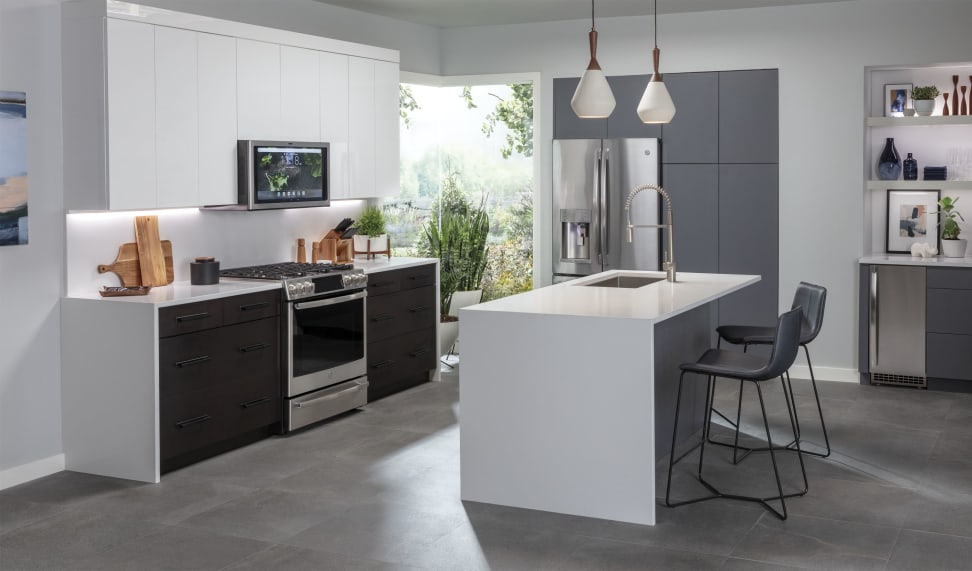Are expensive appliances really worth the money?
Is it worth it to invest in high-end appliances? It depends.
 Credit:
GE
Credit:
GE
Products are chosen independently by our editors. Purchases made through our links may earn us a commission.
Walk through the appliance section at a big box store like Home Depot and Lowes and you'll see products ranging from just a few hundred dollars to well over a few thousand. Sure, the pricey models have features that sound great—and they certainly look fancier—but are expensive appliance worth it?
We've tested thousands of appliances from cheap washers to ultra-expensive refrigerators, so we have years of data to help you figure it out. Though you'll want to check out our guides to the best dishwashers, best washers and dryers, best refrigerators, and best ovens for the most up-to-date recommendations, here's a guide to what you generally get with expensive appliances.
Washers and Dryers

High-end top loaders tend to be large and better looking than their affordable counterparts.
Washing machines come in two flavors: top and front loaders. For top loaders, high prices translate to larger machines with nicer finishes. Let's take, for example, the Maytag MVWB965HC, which retails for over $1,000. The charcoal gray color adds about $100 over the basic white model, but otherwise you're paying for a larger capacity machine. For example, the Maytag MVWB865HC is basically the same feature-wise, but it's $300 cheaper and about 13% smaller than the 965.

Steam is a feature typically only found on higher-end washers.
When it comes to front-load washers, the jumps in price tend to correspond with more features. So the LG WM3770HWA is about $200 more than the similarly performing LG WM3270CW. They are both the same size and color but the major differences are that the 3770 can sanitize and has a 30-minute "Normal" wash cycle.
You see this across other brands as well; the time-saving features and those that require an internal water heater are reserved for flagship models.
Refrigerators

Expensive French-door fridges offer more storage space and better organization.
When it comes to expensive refrigerators there are two teirs: french doors and built-ins. French-door fridges offer more storage space, easier access to items, and usually better food preservation.
One of our top-scoring fridges, the GE Café CYE22UELDS, has everything from an adjustable-temperature deli drawer to a hot-water dispenser. On top of all that, this 28.6-cu.-ft. model did an excellent job keeping a steady temperature in both the fridge and freezer section. Bottom line, when it comes to refrigerators, the more you pay, the more you tend to get.

Built-in fridges like the Sub-Zero Pro 48 tend not to preserve food very well but are impressive to look at nonetheless.
Built-in fridges are models that need to be installed into a cabinet, and are the kind of thing you'll typically only find in a luxury home. In terms of design, they are the creme-de-la-creme, but performance-wise our tests show them to be lacking. These fridges are designed to look grand, and little else matters. They require a lot of maintenance and don't preserve food well. However, if you have enough money to drop over $10,000 you probably don't care.
Dishwashers
In a nutshell, the higher the cost of a dishwasher, the less you need to think about it. High-cost dishwashers tend to come with features like third racks (so you have more room for cups and bowls) and options liked Heated Dry so dishes can come out and go right into your cabinets.

The My Way rack is a high-end feature from Bosch. It's a third rack that can hold bowls.
On top of all that, premium brands like Bosch and Miele have a reputation for making dishwashers that just work. Let's look at the Bosch 800 series, which our lab tests show is a top performer in all categories.
It looks great, it has specific spots for all manner of random dishes, and it's barely audible. When in operation, the 800 series cannot be heard from another room, producing no more than 39 dBA. That is an order of magnitude quieter than a more affordable Whirlpool, and addresses one of the most common complaints people have about their existing dishwashers.
While we love the Bosch 800 Series, it's worth noting that we've tested plenty of affordable dishwashers that will blast your dishes clean. They are typically uglier, louder, and have fewer features, but they get the job done.
Ovens
In most cases, spending more on an oven gets you more power and more versatility. A high-end burner can output over 18,000 BTU, compared to 12,000 for an ordinary range. The added power means you can get a better sear on meat, boil water faster, and stir fry like a pro. High-end ranges also usually come with a gentle burner that handle delicate tasks like melting chocolate and keeping soups and sauces at a simmer.
Inside the oven, a more expensive oven will typically give you even and consistent heat. Consider the KitchenAid KSDB900ESS, which is pretty pricey. Its oven has a true convection feature, offering a quick preheat and fairly even baking results. There are more knobs, buttons, and features to learn, but you'll have much tighter control over how your oven cooks your food with a top-notch oven compared to a basic model.
Are expensive appliances worth it?
Ultimately, it depends on what your needs are. Appliances are some of the most visible and long-lasting components of your home. A beautiful kitchen renovation can be marred with a cheap, ugly-looking appliance. Though there are plenty of great-looking affordable models, the high-end is often about marrying performance, unique features, and beautiful design.
Is that worth it? You'll need to decide for yourself, but our tests can at least shine some light on where your money is going.
